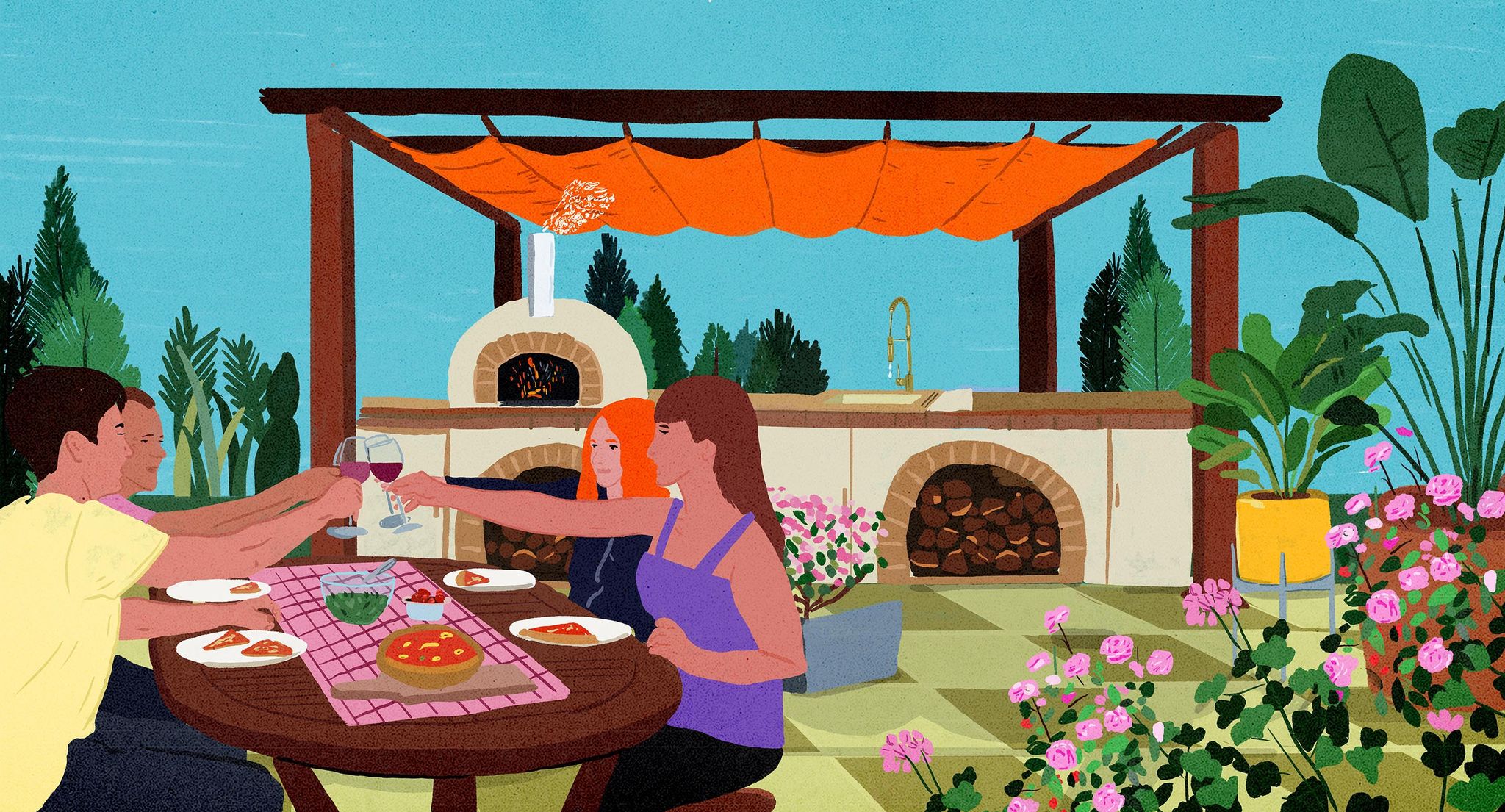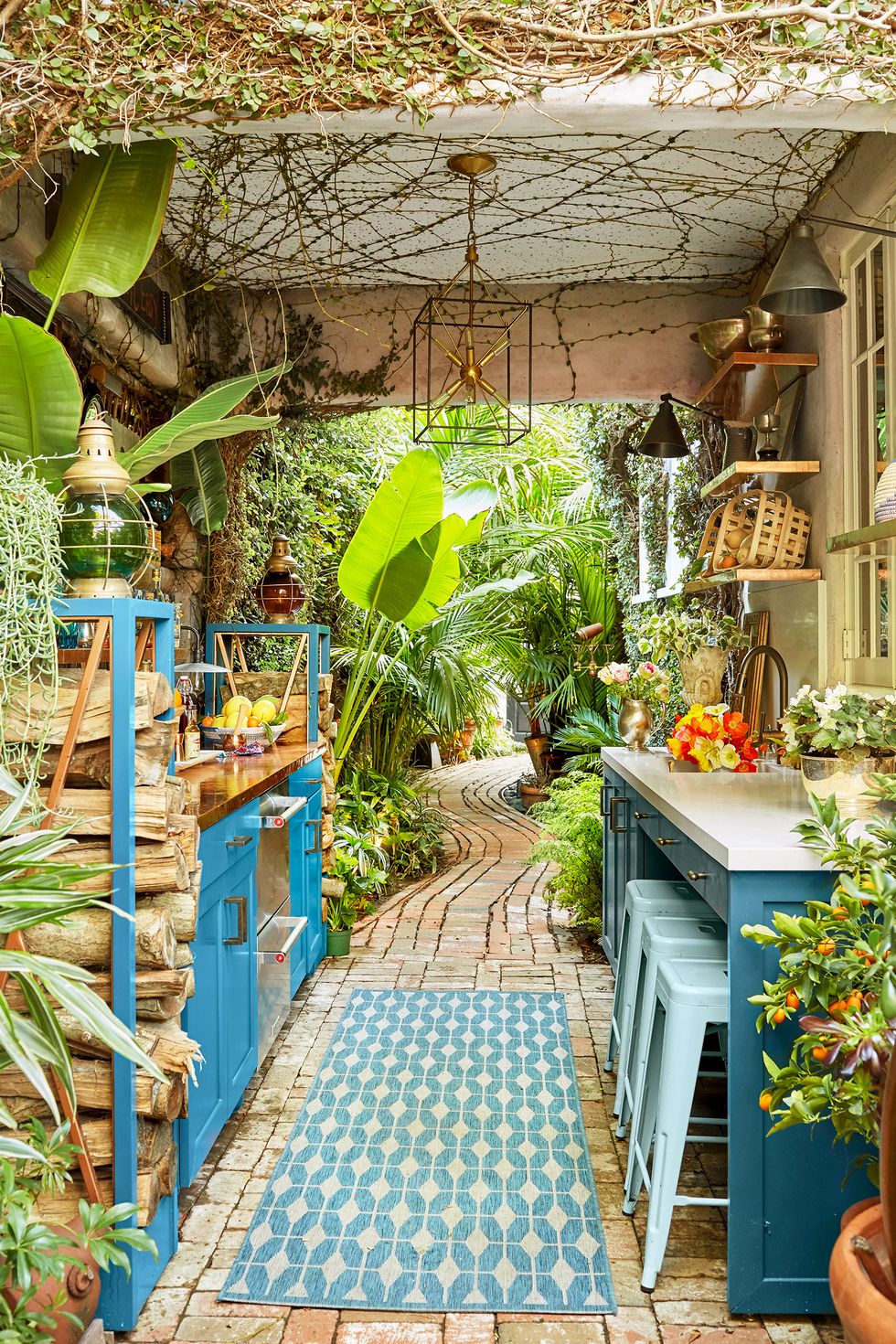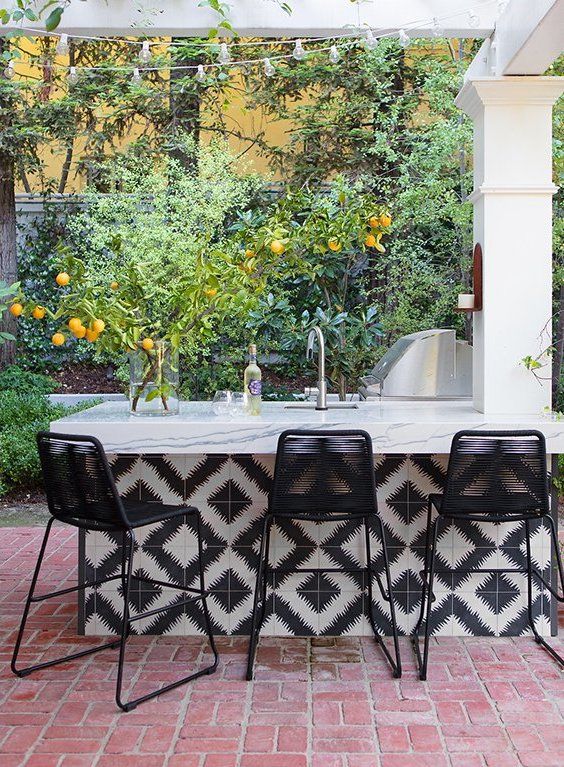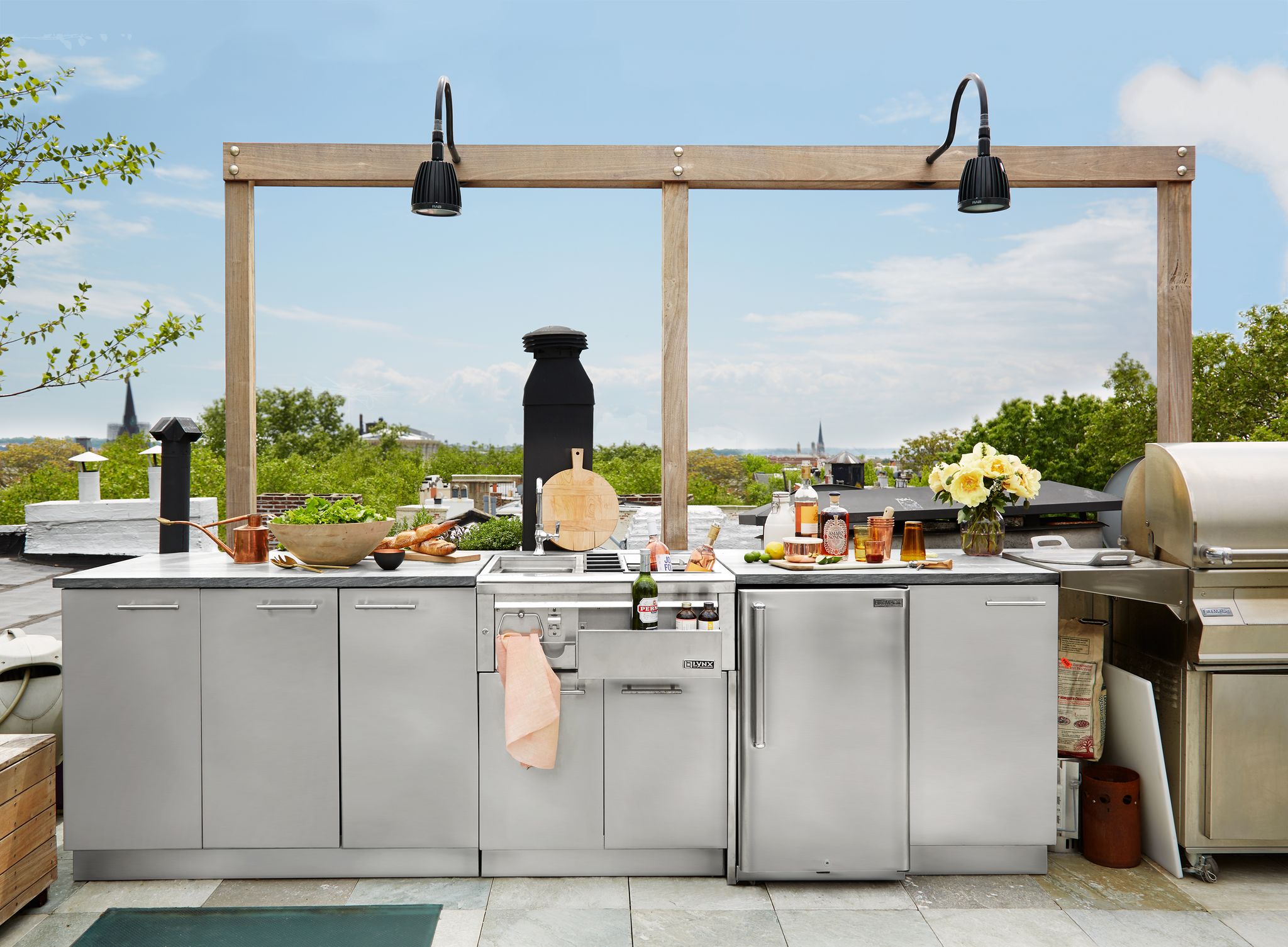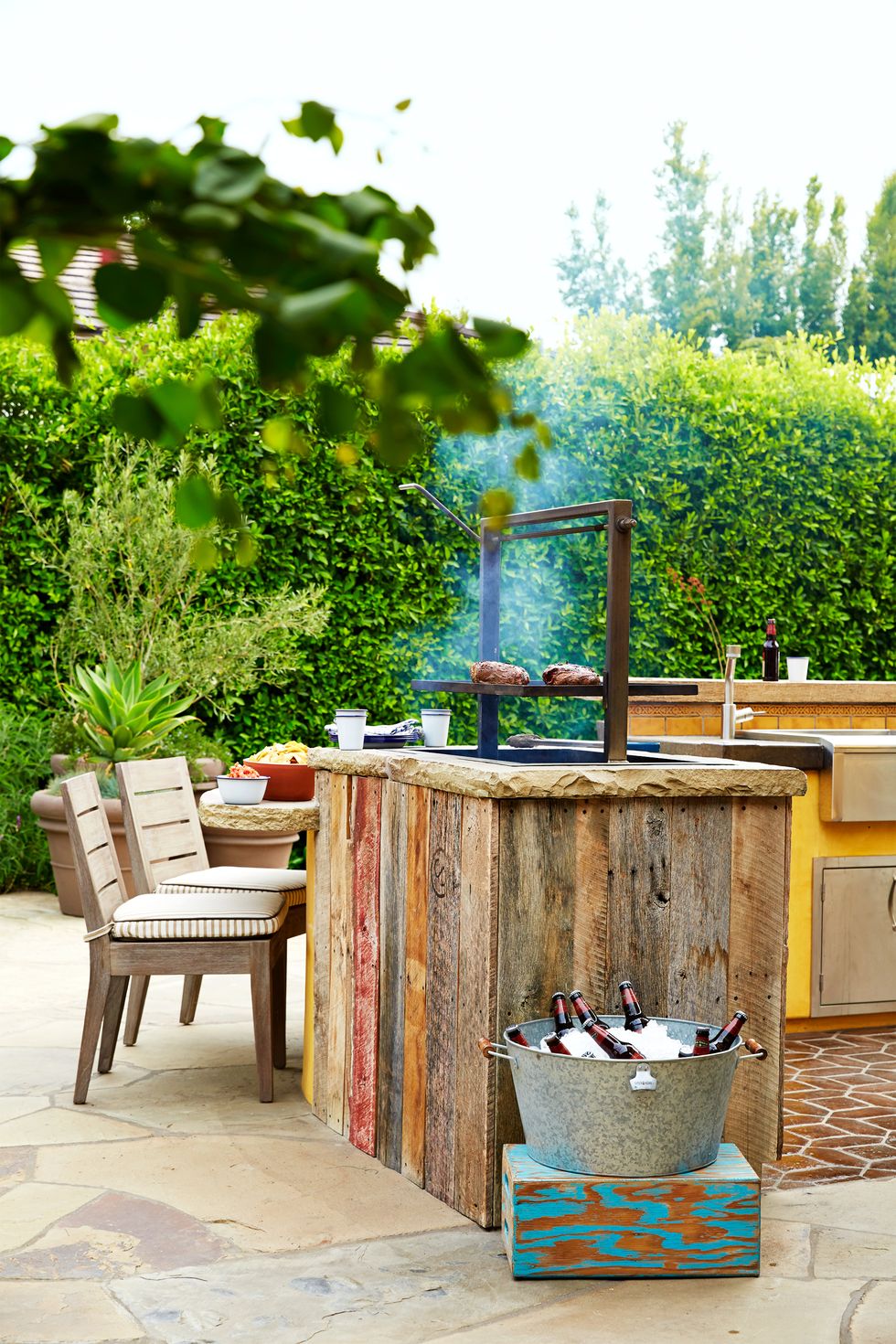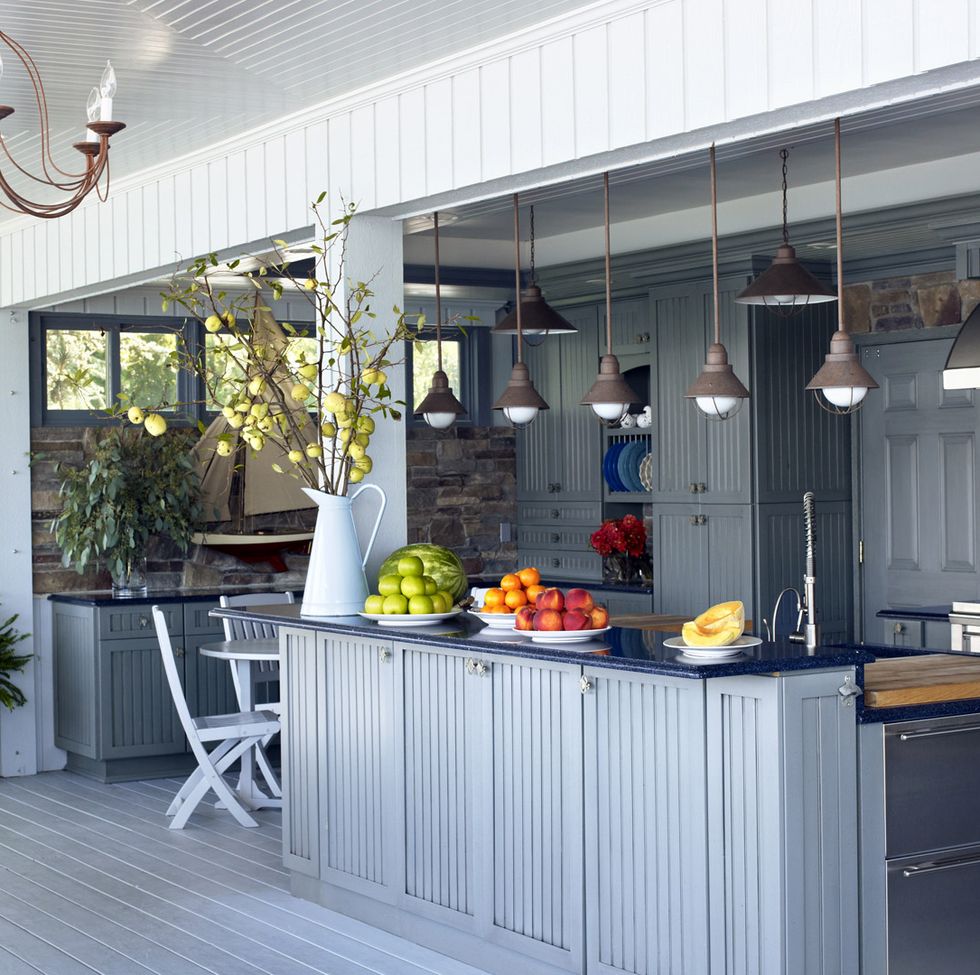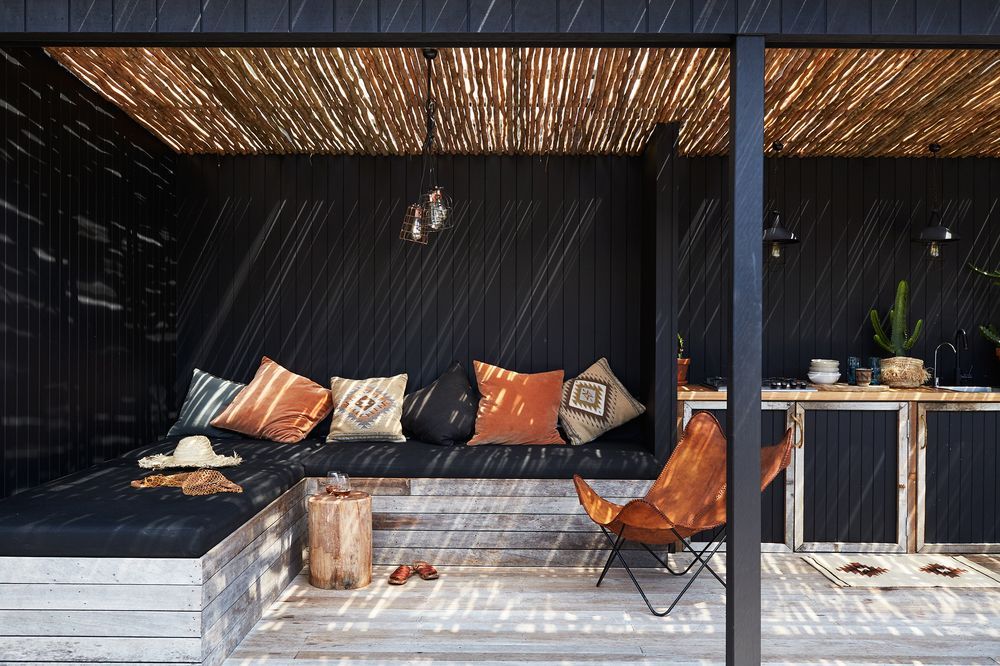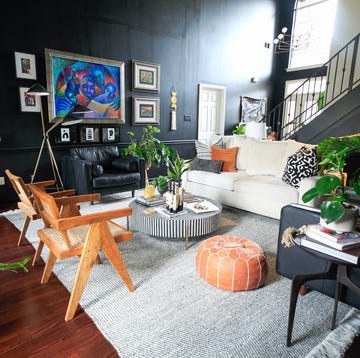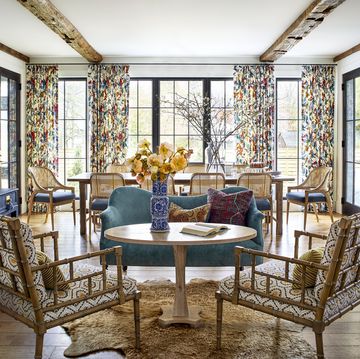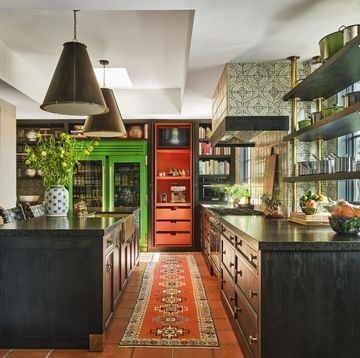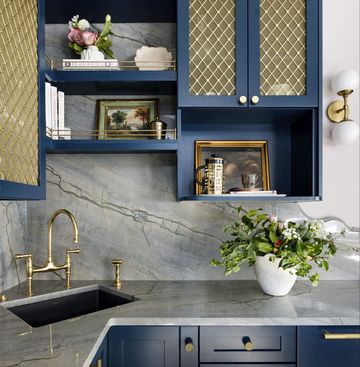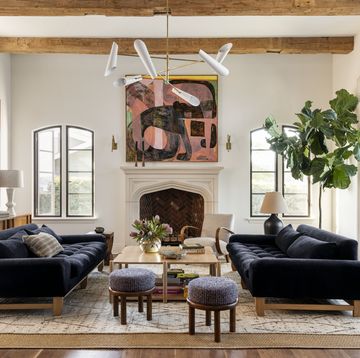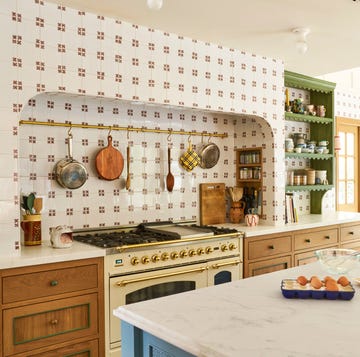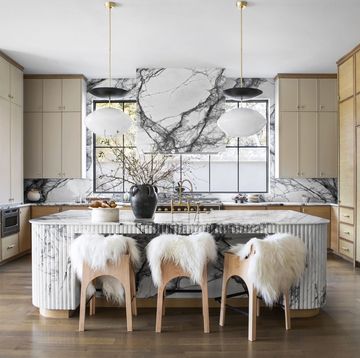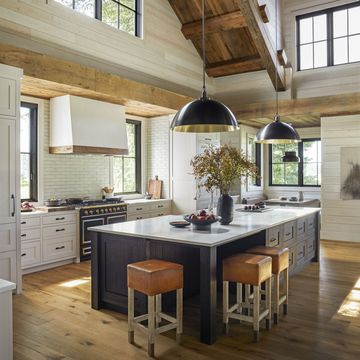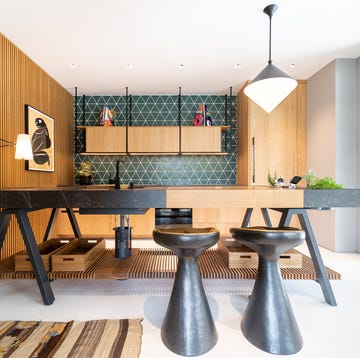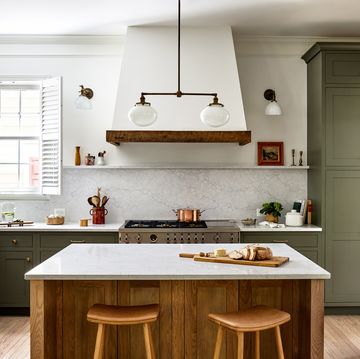Real estate agents report that outdoor kitchens are at the top of the wish list for nearly half of all home buyers. Picture it: freshly woodfired pizzas and ice-cold beverages doled out to your guests under a few strings of twinkly lights, and no one has to set foot indoors to make it possible. Making this a reality, however, is more involved than unfurling an outdoor rug and plopping a chaise on it. You've got to book contractors and shop for appliances as well as plan a thoughtful (and local-planning-board-approved) layout complete with plumbing, electrical, and plants. Kaitlin Petersen, editor in chief of trusted industry resource Business of Home, spoke with the experts to simplify the process. Read on to learn how to have an outdoor kitchen of your own—and boost your home's resale value in the process.
PLANNING
Design a layout. Indoors, your kitchen is confined by walls. But outside, the only limits are the confines of your imagination and your backyard (or zoning regulations about how far from the lot line your setup needs to be). “Build off the capacity the land has naturally given you while taking [into account] aesthetics, budget, square footage, the home’s architecture and how you want the space to function,” says Atlanta-based designer Theresa Ory. Many of the design principles you’d use in your interiors still apply—for example, creating “zones” that maximize efficiency for food preparation.
Don’t forget about landscaping. “The surroundings play a major part in the feeling you get from being out there,” says Maryland-based designer Quintin Tate of Twenty Sevyn Interiors. What do you want to be looking at while you stand at the grill, or while your guests are bellied up to the island? If you’ve got an unsightly shed or a messy neighbor, it’s worth considering how to adjust the layout accordingly.
Budget strategically. The actual cost of adding an outdoor kitchen to your property depends on what you’re looking for, scope and design-wise. But the materials, labor (concrete doesn’t pour itself), and appliances for a hardscaped space can quickly add up: “Are we talking about a sweet cottage with a little outdoor vignette? That might be $20,000. Or is it a covered space, or more like an indoor kitchen in features and size? Better plan on spending at least $50,000, and probably more,” says Ory.
While clients often think of their outdoor spaces as secondary to the main house, Los Angeles–based designer Linda Hayslett says to expect to budget as much (or more) than the cost of your indoor kitchen. “While interior kitchens have hard surfaces, outdoor kitchens have really hard surfaces,” she explains. “Things like laying stone or [bringing in] trucks to lay the rebar for the concrete—it’s a big expense.” Appliances can also push the budget upward thanks to the extra costs associated with weatherproofing. (You’re not just asking that refrigerator to keep your drinks cold; it’s doing the work in the 90-degree sun, which requires extra insulation.) “I always advise budgeting for good barbecues and appliances, because they are outdoors, and the sun is going to do damage. You want to get the best product so it lasts as long as possible.”
If resale is top of mind and you’re leery of investing, take heart: More outdoor space has been a major driver for home buyers for the past few years, and real estate agents say that a full outdoor kitchen is at the top of the wish list for nearly half of all buyers—especially in warmer regions where outdoor entertaining is a year-round activity.
Spec out utilities. Ory recently designed an outdoor kitchen in tandem with the new home’s interiors, which made it much easier to lay gas and electric lines during construction. “That kind of infrastructure ideally happens as early as possible, especially if it’s a new build, because you can map out everything you need,” she explains. “I have another client who brought me on after they had broken ground and never talked about the outdoor spaces during the build. Now we’re weighing how much it is going to cost to run utilities out there versus what we cut from the outdoor kitchen’s design plan.”
Strategic placement of those utilities matters, too. “It’s important to understand what appliances you're getting so that you can lay it all out so you don't see the gas, electric, or plumbing,” says Hayslett. “People don’t realize that you can hide those things with advanced planning—for example, if you’re doing a pergola, we can hide the wires by drilling through the posts.” Last but not least, remember to incorporate outdoor speakers! You’ll want a sound system when it comes time to entertain.
If running water is essential to your ideal outdoor kitchen, you’ll also need to route a water line to your chosen site. While some designers opt for a tap—or, even better, an outdoor-rated dishwasher (no more carrying a tray of dirty dishes inside)—others say it may not be worth the fuss. “With all of a faucet’s hinged elements, it catches more grit and gets gross fast—and in my experience, clients stop using it,” says Ory.
“Plenty of people have outdoor kitchens without sinks. If a sink is imperative for what you’d like to create, try to get some sort of coverage, whether it’s a design element or the eave of the house, so that it will serve you better longer.”
DESIGNING
Make your surfaces last. You’ll want to choose durable surfaces that can stand up to the elements. Hayslett recommends natural stone for built elements and synthetic planks by Trex for a wood-like look that’s far less maintenance and has a longer lifespan than traditional decking (“You just hose off the dust or sand and that’s it”).
She also employs concrete for everything from countertops and surfaces to flooring. “Concrete has come a long way, and you don’t have to get it in that traditional concrete color,” she says. A variety of pigments and finishes on the market yield surprising, sophisticated results alongside the durability the material is known for.
Find the right appliances. These days, there’s an outdoor gadget for every cooking fad, but consider your cooking and entertaining routine before cluttering up your layout. “What you’ll use [outside] is what you already do [inside],” she says. “For everything other than the grill, I’m taking cues from what the client is already doing and how that would translate to outside.”
“A Big Green Egg takes time to get running, and it cooks low and slow,” says Ory. “Some people love that, but if you’re too busy running the kids to soccer practice and you need a 30-minute meal, focus on a grill and a griddle. If you want an all-day, grab a glass of wine–style hangout, focus on the smoker and cooking elements that take more time.” And if you’re more into casual entertaining than cooking, you’ll want to prioritize the outdoor ice machine, a double fridge and some cooling drawers instead of more heating elements.
At bare minimum, Haylett says every outdoor kitchen needs three things: "a really good barbecue, a beverage fridge and a trash can.” (She recommends a built-in garbage can—unglamorous, but super useful.) Tate offers another pared-back, more affordable approach, encouraging clients to install a deep cooler in the countertop in lieu of a refrigerator and channel their budget into a gas stovetop with a hood and ample work surfaces.
A word to the wise: If you’re not sure if an applianceg is suitable for outdoor use, it’s probably not. “Don’t go to your typical big-box store and buy an interior faucet for your outdoor kitchen,” cautions Tate. Instead, head to an appliance retailer’s outdoor section for options that are guaranteed to stand up to the elements. Retailers can also tell you what’s trending in your market. This year, nationwide appliance seller AJ Madison picked a 30-inch pizza oven, keg fridge, two-burner grill, an apron sink, a panel-ready ice maker, a warming drawer, a wine fridge and a cocktail station, and a modular island setup as its top picks.
The Best Bonus Features
Want to go beyond the grill? These extras will bring your party to life.
Be smart about storage. Storage may be the holy grail of indoor kitchens, but it’s not necessarily so outdoors. “Outdoor storage drawers aren’t sealed, so they have a higher capacity for accumulating cobwebs, rain and dirt,” says Ory, who encourages clients to minimize cabinetry outside. “In reality, you’re going to have one or two spatulas you like and a big enough drawer to accommodate them indoors. It’s easy to grab the utensils and go when you’re prepping everything to take it outside, and then they’re already clean.”
For outdoor entertaining essentials like cushions and covers, Hayslett recommends built-ins like banquettes—she’s done them around dining tables and fire pits alike—to keep pillows, blankets and accessories close at hand. (Otherwise, they can get wet in storms, blow away in the wind, or fade in the scorching sun.) “If you have to go to a shed or the garage, you’ll only pull out a few things because you won’t want to deal with the rest,” she says. “If it’s right there, it won’t feel like a chore to pull everything out.”
If a secondary zone like a fire pit isn’t in the cards and you desperately need more storage, consider an island with cabinets or drawers built in. “Indoors or out, it’s the jewelry of the kitchen,” says Tate. Plus, it doubles as somewhere to serve guests that’s set apart from the heating elements like the cooktop or the grill.
Raise a roof. No matter what climate you live in, a bit of coverage—whether it’s an overhang, an awning, a pergola or a shade structure—can be a welcome relief from both sun and rain. “It’s so cool when it's drizzling but you can still go out and make some s’mores and hot cocoa around the fire,” says Hayslett. And even sun lovers will appreciate strategic respites from UV rays. “I’ve done a lot of shades that still allow some light to get through,” she says.
In addition to making your space more usable and versatile, adding some sort of roof creates opportunities for ventilation and lighting, whether it’s a ceiling fan, a chandelier for the dining table or a trio of pendants over the bar. The more coverage you have, the more flexibility you have in shopping for furniture that isn’t graded for full sun, and can make the entire space easier to clean. “My favorite is the half and half—a covered living space with a ceiling fan, a fireplace and an outdoor sectional, and then a dining space that’s fully outdoors with a grill and a pizza oven,” says Tate.
HACKING IT
On a budget? Try these cost-saving solutions to amp up your outdoor space.
Go modular. Chain retailers like West Elm and Pottery Barn, e-tailers like Wayfair, and specialty vendors all carry a variety of outdoor kitchen systems, with prices ranging from $2,000 to more than $10,000 for a model with the range built in. These models can come as either one unit or as mix-and-match modules that you assemble on your own. Either way, consider which appliances you want to leave room for before you start browsing. If you’re not in your forever home, modular options can be a great alternative to spending big on a permanent fixture. To shop smart, invest in models made from better materials that come with protective covers.
Build a fire pit. If you’re short on budget or space, a fire pit offers plenty of the benefits of an outdoor kitchen—including a place to gather, a central attraction and a way to cook dinner—at a fraction of the cost. It’s also the top outdoor feature for homebuyers, according to a recent survey of real estate agents. Go glam with hardscaped benches to stow cushions, blankets and long-handled roasting forks, or look for eco-friendly Adirondack-style chairs fashioned from recycled ocean plastic. If you don’t want to deal with keeping a blaze going, Tate recommends a crystal fire pit, which is powered by propane and ignites with the flip of a switch.
Skip the utilities. If you’re planning to DIY your outdoor kitchen, save money by foregoing hard-wired electric, gas and water hookups. You can still build a stunning prep space anchored around a propane grill, an ice-filled bin for drinks (a built-in spigot to drain it makes clean-up a breeze), and solar-powered string lights as twilight sets in.
Follow House Beautiful on Instagram.






